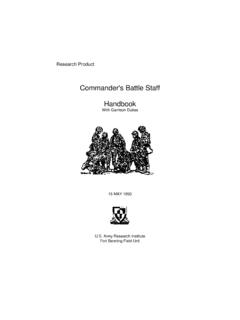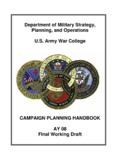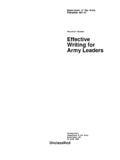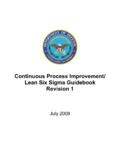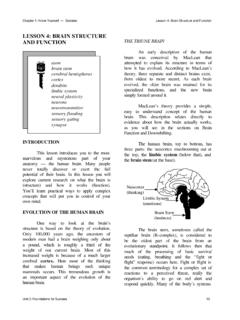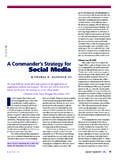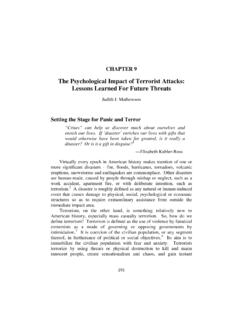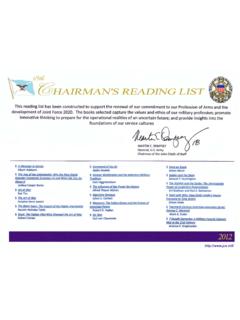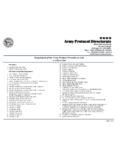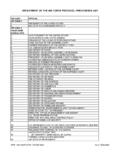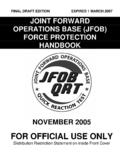Transcription of Joint Org & Staff Functions - Air University
1 1-1 JFSC PUB 1 Joint Organization and Chapter 1 Staff Functions Introduction 1-2 Background 1-2 Organization for National Security 1-3 Military Departments 1-7 Evolution of the Joint Chiefs of Staff 1-19 Organization of the Joint Chiefs of Staff 1-20 The Joint Staff 1-25 Joint Boards, Commissions, and Committees 1-25 Combatant Commands 1-28 Unified Command Plan 1-30 Command Relationships 1-31 Joint Staffs 1-45 Joint Specialty Officer (JSO) 1-53 Multinational Commands 1-54 Joint Professional Military Education (JPME) 1-55 1-2 JFSC PUB 1 Joint Organization and Staff Functions 100.
2 INTRODUCTION References: Title 10 United States Code (as amended) DOD Directive , Functions of the Department of Defense and Its Major Components DOD Directive , Organization of the Joint Chiefs of Staff and Relationships with the Office of the Secretary of Defense Organization of the Joint Chiefs of Staff , Action Officer Orientation Handbook Joint Admin Pub , Organization and Functions of the Joint Staff Joint Pub 0-2, Unified Action Armed Forces (UNAAF) Unified Command Plan (UCP) Staff Report to the Committee on Armed Services, United States Senate, October 16, 1985 Numerous governmental organizations are involved in the implementation of national security policy. This chapter focuses primarily on the organizations and agencies responsible for the planning and execution of Joint military operations, their organiza-tional structures, and their command relationships.
3 101. BACKGROUND a. Civilian control of the military. Since the founding of the nation, civilian con-trol of the military has been an absolute and unquestioned principle. The Constitution incorporates this principle by giving both the President and Congress the power to ensure civilian supremacy. The Constitution establishes the President as the Commander-in-Chief, but gives the Congress the power to declare war , to raise and support Armies provide and maintain a Navy (and) to make Rules for the Government and Regulation of the land and naval Forces. b. Joint Organization before 1900. As established by the Constitution, coordina-tion between the War Department and Navy Department was effected by the President as the Commander in Chief. Army and naval forces functioned autonomously with the President as their only common superior.
4 Despite Service autonomy, early American his-tory reflects the importance of Joint operations. Admiral MacDonough s naval operations on Lake Champlain were a vital factor in the ground campaigns of the War of 1812; the Joint teamwork displayed by General Grant and Admiral Porter in the Vicksburg 1-3 JFSC PUB 1 Campaign of 1863 stands as a fine early example of Joint military planning and execution. However, instances of confusion, poor inter-Service cooperation and lack of coordi-nated, Joint military action had a negative impact on operations in the Cuban campaign of the Spanish-American War (1898). By the turn of the century, advances in technology and the growing international involvement of the United States required greater coopera-tion between the military departments. c. Joint history through World War I. As a result of the unimpressive Joint military operations in the Spanish-American War, in 1903; the Secretary of War and the Secretary of the Navy created the Joint Army and Navy Board charged to address all matters calling for cooperation of the two Services.
5 The Joint Army and Navy Board was to be a continuing body that could plan for Joint operations and resolve problems of common concern to the two Services. Unfortunately, the Joint Board accomplished little, because it could not direct implementation of concepts or enforce decisions, being limited to commenting on problems submitted to it by the secretaries of the two military depart-ments. It was described as a planning and deliberative body rather than a center of ex-ecutive authority. As a result, it had little or no impact on the conduct of Joint opera-tions during the first World War. Even as late as World War I, questions of seniority and command relationships between the Chief of Staff of the Army and American Expedi-tionary Forces in Europe were just being resolved. d. Joint History through World War II. After World War I, the two Service sec-retaries agreed to reestablish and revitalize the Joint Board.
6 Membership was expanded to six: the chiefs of the two Services, their deputies, and the Chief of War Plans Division for the Army and Director of Plans Division for the Navy. More important, a working Staff (named the Joint Planning Committee) made up of members of the plans divisions of both Service staffs was authorized. The new Joint Board could initiate recommenda-tions on its own. Unfortunately, the 1919 board was given no more legal authority or re-sponsibility than its 1903 predecessor; and, although its 1935 publication, Joint Action Board of the Army and Navy (JAAN), gave some guidance for the unified operations of World War II, the board itself was not influential in the war. The board was officially disbanded in 1947. 102. ORGANIZATION FOR NATIONAL SECURITY. Knowledge of relation-ships between elements of the national security structure is essential to understanding the role of Joint Staff organizations.
7 Figure 1-1 illustrates the principal officials and organi-zations that make and execute national security decisions. a. National Command Authorities (NCA) (1) Constitutionally, the ultimate authority and responsibility for the national de-fense rests with the President. 1-4 JFSC PUB 1 Figure 1-1 (2) The National Command Authorities (NCA) are the President and Secre-tary of Defense or persons acting lawfully in their stead. The term NCA is used to signify constitutional authority to direct the Armed Forces in their execution of military action. Both movement of troops and execution of military action must be directed by the NCA; by law, no one else in the chain of command has the authority to take such action except in self-defense. (3) Since passage of the National Security Act of 1947, the President has used his Secretary of Defense as his principal assistant in all matters relating to the Depart-ment of Defense.
8 The Secretary is responsible for the effective, efficient, and economical operation of the Department of Defense, and he has statutory authority, direction, and control over the military departments. b. National Security Council (NSC). The National Security Council was estab-lished by the National Security Act of 1947 as the principal forum to consider national security issues that require Presidential decision. Its membership now includes only four PresidentNCAVicePresidentSecretaryof StateSecretary ofDefenseNSCA dvisersDAFS ecretaryNavyDONS ecretaryArmyUSADACSAO perational ResponsibilitiesSupport ResponsibilitieszCombatant CommandzDirective AuthorityzOperation PlanningzStrategic DirectionzMilitary AdviceUSMCCMCUSNCNOUSAFCSAFJCSJ ointStaffChairman,JCSVice Chairman,JCSC ommanderSubunifiedCommandCommanderCompon entCommandCommanderJoint TaskForceCombatantCommanderNSCzOrganizez TrainzEquipzMaintainzAssignzSupportOrgan ization for National SecuritySecretaryAir ForceCOCOMADCON1-5 JFSC PUB 1 statutory members: the President, the Vice President, the Secretary of State, and the Secretary of Defense.
9 The Chairman of the Joint Chiefs of Staff (CJCS) and the Director of Central Intelligence serve as statutory advisers to the NSC. The history of the NSC and its organization are discussed in Chapter 5. c. Department of Defense (DOD) (1) The Joint Board of the Army and Navy was the first attempt to use a regu-larly constituted agency to coordinate the actions of the Army and the Navy. During the 1920s and 1930s, Congress made several fiscally motivated studies intended to reorgan-ize the military. In June 1924, a Joint Congressional committee recommended that a sin-gle Department of Defense be formed under one cabinet officer; no action was taken on the report. In 1932 the House considered a bill that would have permitted the President to establish a Department of National Defense and, as the President saw fit, subject to ap-proval of Congress, transfer and consolidate Functions of executive departments.
10 The es-tablishment of a single defense department was eventually rejected by the House. During the reorganization debates, there was strong opposition to a single defense department among the military. The Joint Board of the Army and Navy stated in May 1933: The Joint Board is unable to recommend an organization for a Department of National De-fense that would be more efficient or more economical than the present separate depart-mental organizations. In the opinion of the Board, amalgamation of the two Departments would be a grave error. (2) The evolution of a single executive department responsible for national de-fense was marked by caution, indecision and, from some circles, open hostility. But World War II and the new demands placed on the Armed Forces furnished the nec-essary impetus for unification of the military departments under a single cabinet-level secretary.
